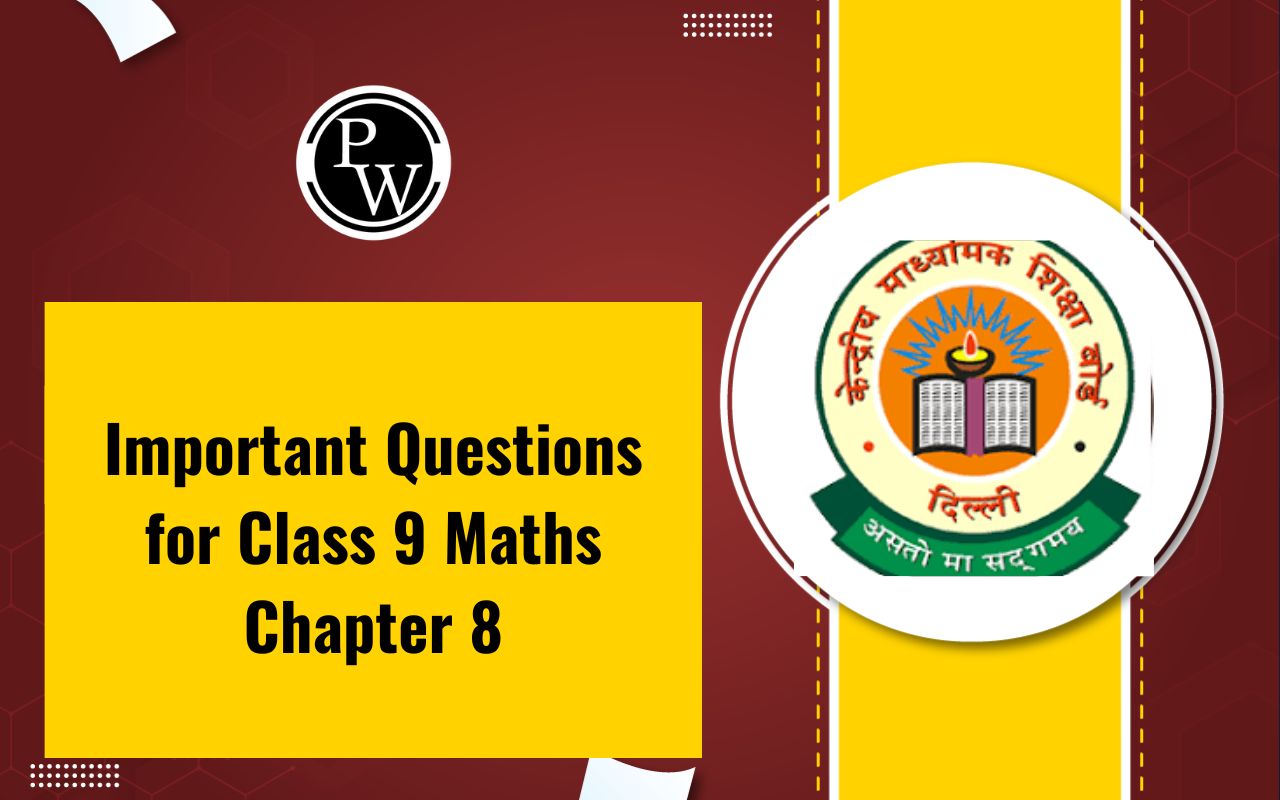

Important Questions for Class 9 Maths Chapter 8: Here are the important questions for Class 9 Maths Chapter 8 Quadrilaterals that students should focus on to strengthen their understanding of the topic. These questions cover the properties and types of quadrilaterals, such as parallelograms, rectangles, squares, rhombuses and trapeziums.
Students should practice applying theorems related to the diagonals of parallelograms and exploring the relationships between angles. By tackling these important questions, students will enhance their problem-solving abilities and gain a deeper insight into the geometric relationships within quadrilaterals, laying a solid foundation for further studies in mathematics.Important Questions for Class 9 Maths Chapter 8 Overview
Here are the important questions for Class 9 Maths Chapter 8 Quadrilaterals has been created by subject experts of Physics Wallah to help students understand the key concepts. These questions cover different types of quadrilaterals, such as parallelograms, rectangles, rhombuses, squares and trapeziums. Students will find questions about identifying and proving the properties of these shapes, as well as solving problems related to angles and sides. By practicing these expert-created questions, students can improve their understanding, enhance their problem-solving skills,and get ready for their exams building a solid foundation in geometry.Important Questions for Class 9 Maths Chapter 8 PDF
The PDF link for the Important Questions for Class 9 Maths Chapter 8 is available below. This resource is crated to provide students with a detailed set of key questions that focus on the essential concepts of quadrilaterals. By using this PDF students can easily access practice questions that cover various topics within the chapter, helping them to reinforce their understanding and prepare effectively for their exams. Make sure to download the PDF and practice these important questions to enhance your math skills and boost your confidence.Important Questions for Class 9 Maths Chapter 8 PDF
1. What is a quadrilateral? Mention 6 types of quadrilaterals.
Solution:
A quadrilateral is a four-sided polygon with a closed shape. It is a two-dimensional geometric figure characterized by having four edges (sides) and four vertices (corners).Types of Quadrilaterals
Here are six types of quadrilaterals:Rectangle : A quadrilateral with opposite sides that are equal in length and all angles measuring 90 degrees.
Square : A special type of rectangle where all four sides are equal in length and all angles are 90 degrees.
Parallelogram : A quadrilateral with opposite sides that are parallel and equal in length. The opposite angles are also equal.
Rhombus : A type of parallelogram where all four sides are equal in length. The opposite angles are equal, and adjacent angles are supplementary.
Trapezium (Trapezoid) : A quadrilateral with at least one pair of parallel sides. The non-parallel sides are called the legs.
Kite : A quadrilateral with two distinct pairs of adjacent sides that are equal in length. The diagonals intersect at right angles, and one diagonal bisects the other.
2. The diagonals of which quadrilateral are equal and bisect each other at 90°?
Solution:
Square. The diagonals of a square are equal and bisect each other at 90°.3. Identify the type of quadrilaterals:
(i) The quadrilateral formed by joining the midpoints of consecutive sides of a quadrilateral whose diagonals are perpendicular.
(ii) The quadrilateral formed by joining the midpoints of consecutive sides of a quadrilateral whose diagonals are congruent.
Solution:
(i) The quadrilateral formed by joining the midpoints of consecutive sides of a quadrilateral whose diagonals are perpendicular is a rectangle . (ii) The quadrilateral formed by joining the midpoints of consecutive sides of a quadrilateral whose diagonals are congruent is a rhombus .4. Find all the angles of a parallelogram if one angle is 80°.
Solution:
For a parallelogram ABCD, opposite angles are equal. So, the angles opposite to the given 80° angle will also be 80°. It is also known that the sum of angles of any quadrilateral = 360°. So, if ∠A = ∠C = 80° then, ∠A + ∠B + ∠C + ∠D = 360° Also, ∠B = ∠D Thus, 80° + ∠B + 80° + ∠D = 360° Or, ∠B +∠ D = 200° Hence, ∠B = ∠D = 100° Now, all angles of the quadrilateral are found which are: ∠A = 80° ∠B = 100° ∠C = 80° ∠D = 100°5. In a rectangle, one diagonal is inclined to one of its sides at 25°. Measure the acute angle between the two diagonals.
Solution:
Let ABCD be a rectangle where AC and BD are the two diagonals which are intersecting at point O. Now, assume ∠BDC = 25° (given) Now, ∠BDA = 90° – 25° = 65° Also, ∠DAC = ∠BDA, (as diagonals of a rectangle divide the rectangle into two congruent right triangles) So, ∠BOA = the acute angle between the two diagonals = 180° – 65° – 65° = 50°6. Is it possible to draw a quadrilateral whose all angles are obtuse angles?
Solution:
It is known that the sum of angles of a quadrilateral is always 360°. To have all angles as obtuse, the angles of the quadrilateral will be greater than 360°. So, it is not possible to draw a quadrilateral whose all angles are obtuse angles.7. Prove that the angle bisectors of a parallelogram form a rectangle.
Solution:
LMNO is a parallelogram in which bisectors of the angles L, M, N, and O intersect at P, Q, R and S to form the quadrilateral PQRS. LM || NO (opposite sides of parallelogram LMNO) L + M = 180 (sum of consecutive interior angles is 180o) MLS + LMS = 90 In LMS, MLS + LMS + LSM = 180 90 + LSM = 180 LSM = 90 RSP = 90 (vertically opposite angles) SRQ = 90, RQP = 90 and SPQ = 90 Therefore, PQRS is a rectangle.8. In a trapezium ABCD, AB ∥ CD. Calculate ∠ C and ∠ D if ∠ A = 55° and ∠ B = 70°
Solution:
In a trapezium ABCD, ∠A + ∠D = 180° and ∠B + ∠C = 180° So, 55° + ∠D = 180° Or, ∠D = 125° Similarly, 70° + ∠C = 180° Or, ∠C = 110°9. Calculate all the angles of a parallelogram if one of its angles is twice its adjacent angle.
Solution:
Let the angle of the parallelogram given in the question statement be “x”. Now, its adjacent angle will be 2x. It is known that the opposite angles of a parallelogram are equal. So, all the angles of a parallelogram will be x, 2x, x, and 2x As the sum of interior angles of a parallelogram = 360°, x + 2x + x + 2x = 360° Or, x = 60° Thus, all the angles will be 60°, 120°, 60°, and 120°.10. Calculate all the angles of a quadrilateral if they are in the ratio 2:5:4:1.
Solution:
As the angles are in the ratio 2:5:4:1, they can be written as- 2x, 5x, 4x, and x Now, as the sum of the angles of a quadrilateral is 360°, 2x + 5x + 4x + x = 360° Or, x = 30° Now, all the angles will be, 2x =2 × 30° = 60° 5x = 5 × 30° = 150° 4x = 4 × 30° = 120°, and x = 30°Benefits of Practicicng Important Questions for Class 9 Maths Chapter 8
Practicing important questions for Class 9 Maths Chapter 8 provide several benefits for students:Strengthens Conceptual Understanding : By working through important questions students can deepen their understanding of the chapter's concepts, such as properties of quadrilaterals, theorems and formulas. This solid foundation helps in grasping more complex topics in the future.
Enhances Problem-Solving Skills : Regular practice helps students develop critical thinking and problem-solving skills. They learn to approach various types of problems systematically, improving their ability to tackle new challenges.
Familiarizes with Exam Format : Important questions often reflect the types and styles of questions that may appear on exams. This exposure helps students become comfortable with the exam format and boosts their confidence when facing assessments.
Identifies Weak Areas : By practicing important questions students can identify areas where they may struggle or lack clarity. This awareness allows them to focus their revision efforts on those specific topics, leading to improved performance.
Boosts Time Management Skills : Practicing under timed conditions can help students improve their time management skills, ensuring they can complete their exams efficiently. It teaches them to allocate time wisely to different questions based on their difficulty level.
Encourages Revision : Working through important questions reinforces knowledge and helps in revising concepts learned in the chapter.
Increases Confidence : Successfully answering important questions builds students confidence in their mathematical abilities. This confidence can reduce exam anxiety and contribute to a more positive mindset during assessments.
Important Questions for Class 9 Maths Chapter 8 FAQs
What is a quadrilateral?
What is the sum of the interior angles of a quadrilateral?
What is the difference between a rectangle and a square?
What properties do a rhombus and a rectangle share?












